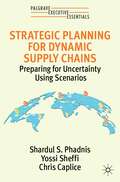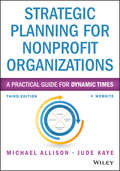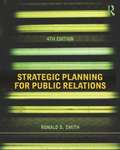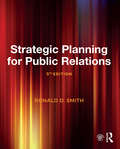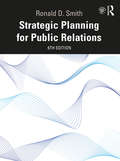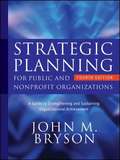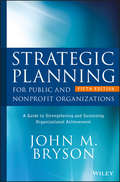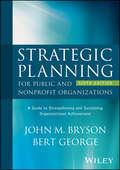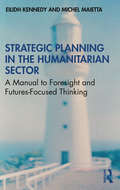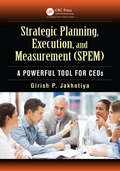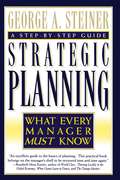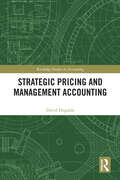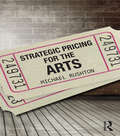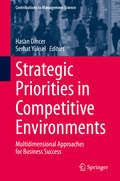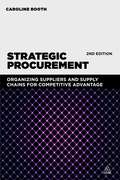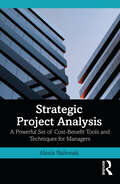- Table View
- List View
Strategic Planning for Dynamic Supply Chains: Preparing for Uncertainty Using Scenarios (Palgrave Executive Essentials)
by Yossi Sheffi Shardul S. Phadnis Chris CapliceThis book presents a strategic decision-making process (i.e., scenario planning) to help managers build supply chain infrastructures that can adapt to uncertain shifts in the business environment. The authors detail the process for developing and applying scenarios for strategic planning in organizations playing three different roles in supply chains. Using three cases in which the process was applied in association with the MIT Center for Transportation & Logistics, this primer also explains how companies can monitor their business environments to decide when to take the necessary steps to adapt their supply chain strategies and assets. The lessons learned are applicable globally: in first-world free-market economies, emerging countries and poorer nations, as well as the states where the government plays a strong role in the economic activity. For companies looking to assess the numerous drivers shaping their supply chains and use that information to make living strategic plans, this book will teach you how to build adaptable and agile supply chains. It will explain how to approach long-term investments in your organization.
Strategic Planning for Nonprofit Organizations
by Michael Allison Jude KayeYour total guide to putting a powerful management tool to work in your organization Why strategic planning? Because a well wrought strategic plan helps you set priorities and acquire and allocate the resources needed to achieve your goals. It provides a framework for analyzing and quickly adapting to future challenges. And it helps all board and staff members focus more clearly on your organization's priorities, while building commitment and promoting cooperation and innovation But to be effective, your plan will need to address the special needs of the nonprofit sector. And for more than a decade, Strategic Planning for Nonprofit Organizations has been the number-one source of guidance on all facets of strategic planning for managers at nonprofits of every size and budget. This thoroughly revised, updated, and expanded edition arms you with the expert knowledge and tools you need to develop and implement surefire strategic plans, including tested-in-the-trenches worksheets, checklists, and tables--in print and on the companion website--along with a book-length case study that lets you observe strategic planning in action. Packed with real-world insights and practical pointers, it shows you how to: Develop a clear mission, vision, and set of values Conduct SWOT analyses and program evaluations Assess client needs and determine stakeholder concerns Set priorities and develop core strategies, goals, and objectives Balance the dual bottom lines of mission and money Write and implement a solid strategic plan Develop a user-friendly annual work plan Establish planning cycles, gauge progress, and update strategies
Strategic Planning for Not-for-Profit Organizations
by David L Loudon Robert E Stevens R Henry Migliore Stanley G WilliamsonStrategic Planning for Not-For-Profit Organizations covers all the steps involved in developing a strategic plan for a not-for-profit organization. Strategic planning has become a critical issue for not-for-profit organizations as they strive for direction and orderly adjustment to a changing environment. In this book, the authors describe a strategic planning process that will help readers bring direction and unity to their organizations and help create a sense of enthusiasm and anticipation as organizations’visions of what they can be begin to unfold. Strategic Planning for Not-For-Profit Organizations is both a tutorial and an easily accessible reference. It is packed with user-friendly information to help readers prepare their own strategic plans and evaluate plans created by others. The book presents essential concepts and techniques in a concise, readily usable form that readers can immediately use in decisionmaking. Worksheets and real-life examples throughout the book help readers in the step-by-step development of strategic plans for their own organizations. A set of appendixes includes a strategic plan outline and presents sample strategic plans so readers can see what one actually looks like and get a head start on theirs. A complete guide to strategic planning for not-for-profit organizations, this book covers everything from writing purpose or mission statements and setting goals to strategy development and evaluation and control procedures. Managers and administrators of not-for-profit organizations will find Strategic Planning for Not-For-Profit Organizations an extremely helpful guide for their planning duties. The book also serves as a valuable text or supplemental reading for college courses on managing not-for-profit organizations.
Strategic Planning for Public Relations
by Ronald D. Smith Deborah A. SilvermanThe seventh edition of Strategic Planning for Public Relations maintains its status as a leading text to guide students in developing successful public relations campaigns.Deborah Silverman and Ronald Smith bring their experience as instructors and public relations professionals to the book, providing clear, step-by-step guidance on how to plan and implement strategic communications campaigns. This new edition includes diverse examples of current cases along with classic cases that stand the test of time. It includes new “Ethics Minutes” scenarios in each step, a new research step, and examples of award-winning public relations campaigns. It also significantly increases information on social media and features a reformatting of the tactics step into four separate parts based on the PESO model (paid media, earned media, shared media, and owned media).As a leader in teaching public relations strategy, this text is ideal for students in upper division undergraduate and graduate courses in public relations strategy and campaigns.Complementing the book are online resources for both students and instructors. For students: step overviews, useful links to professional organizations and resources, checklists for the ten steps in the planning process, and two sample campaigns. For instructors: an instructors’ manual, PowerPoint slides, sample syllabi, a critique evaluation worksheet, and checklists for the ten steps in the planning process. For these online resources, please visit www.routledge.com/9781032391168 .
Strategic Planning for Public Relations
by Ronald D. SmithThis innovative and popular text provides a clear pathway to developing public relations campaigns and other types of strategic communication. Implementing the pragmatic, in-depth approach of the previous editions, author Ronald D. Smith presents a step-by-step unfolding of the strategic campaign process used in public relations practice. Drawing from his experience in professional practice and in the classroom, Smith walks readers through the critical steps for the formative research, strategic and tactical planning, and plan evaluation phases of the process. Offering clear explanations, relevant examples, and practical exercises, this text identifies and discusses the decision points and options in the development of a communication program. The cases and examples included here explore classic real-world public relations situations as well as current, timely events. This fourth edition highlights the results of new research studies on opinions and practices within the discipline, and adds overviews of several award-winning public relations campaigns. As a classroom text or a resource for professional practice, this volume provides a model that can be adapted to fit specific circumstances and used to improve effectiveness and creativity in communication planning. It serves as an accessible and understandable guide to field-tested procedures, offering practical insights that apply to public relations campaigns and case studies coursework.
Strategic Planning for Public Relations
by Ronald D. SmithStrategic Planning for Public Relations is in its fifth edition of offering an innovative and clear approach for students looking to learn how to develop public relations campaigns. It is a text intended for those serious about entering the rapidly changing professions of public relations and strategic communication. Ronald Smith shows how to implement pragmatic, research-driven strategic campaigns used in public relations practice, and draws from his years of experience as a professional in the industry and his years of teaching in the classroom. The approach used in this text is a threefold pattern: first, readers are exposed to new ideas, then see them in use, before finally being showed how to apply those ideas themselves. Complex problem-solving and decision-making processes in strategic communication and public relations are turned into a series of easy-to-follow steps, flexible enough to be applicable to myriad situations and organizations in the real world. This new fifth edition follows the same format as previous editions and includes numerous timely and real-world examples of cases and current events, along with classic cases that stand the test of time. It includes new research on opinions and practices within the discipline and covers several recent, award-winning public relations campaigns.
Strategic Planning for Public Relations
by Ronald D. SmithThe sixth edition of Strategic Planning for Public Relations offers an innovative and clear approach for students wanting to learn how to develop public relations campaigns. Ron Smith shows how to implement research-driven strategic campaigns, drawing on his experience as a professional in the industry and his teaching in the classroom. He turns complex problem-solving and decision-making processes in strategic communication and public relations into easy-to-follow steps, flexible enough to apply to various situations and organizations in the real world. This new edition includes real-world, diverse examples of cases and current events, along with classic cases that stand the test of time. It includes new research on opinions and practices, covers award-winning public relations campaigns, and significantly increases information on social media, with a reformatting of the Tactics section to highlight internet-based and social media. As a leader in teaching public relations strategy, this text is ideal for students in upper division undergraduate and graduate courses in public relations strategy and campaigns. Complementing the book are online resources for both students and instructors. For students: chapter overviews, useful links to professional organizations and resources, and an overview of careers in public relations. For instructors: an instructors’ manual, lecture slides, and sample course materials. Please visit www.routledge.com/cw/smith.
Strategic Planning for Public and Nonprofit Organizations
by John M. BrysonPraise for Strategic Planning for Public and Nonprofit Organizations"This is an immensely valuable resource for leaders, professionals, researchers, and other participants in public and nonprofit settings. Anyone professing competence in public and nonprofit management needs to know what Bryson says about strategic planning and management." -Hal G. Rainey, Alumni Foundation Distinguished Professor, University of Georgia; author, Understanding and Managing Public Organizations, Fourth Edition"John Bryson recognizes that strategic management is what is called for today-meaning strategic planning must be linked to leadership, stakeholder involvement, the budget process, system redesign, and performance management. This is a tall order, but John's updated book delivers the goods and comes at just the right time!" -Beverly Stein, president, Public Strategies Group; former chair, Multnomah County Board of Commissioners (Oregon)"This volume provides a practical theory of how to accomplish the political work of leading organizations through strategic change. The theory is a comprehensive synthesis of research on strategic planning and management. There's no better single reference point for choosing an approach to strategic planning and carrying it through to a successful conclusion." -Michael Barzelay, professor of public management, London School of Economics and Political Science; coauthor, Preparing for the Future: Strategic Planning in the U.S. Air Force
Strategic Planning for Public and Nonprofit Organizations: A Guide to Strengthening and Sustaining Organizational Achievement
by John M. BrysonThe essential planning resource and framework for nonprofit leaders Strategic Planning for Public and Nonprofit Organizations is the comprehensive, practical guide to building and sustaining a more effective organization. Solid strategy is now more important than ever, and this book provides a clear framework for designing and implementing an effective and efficient planning process. From identifying stakeholders and clarifying a shared vision, to implementing plans and revising strategies, the discussion covers all aspects of the process to help you keep your organization united and on track into the future. The field's leading authority shares insight, advice, helpful tools, and specific techniques, alongside a widely used and well-regarded approach to real-world planning. This new fifth edition includes new case studies and examples along with up-to-date resources and references, and new multimedia-related content. Innovation and creativity produce great ideas, but these ideas must be collected and organized into an actionable plan supported by a coalition of support to make your organization great. This book provides expert guidance and perspective to help you bring everything together into a workable organizational strategy. Discover an effective approach to the strategic planning process Identify issues, establish a vision, clarify mandates, and implement plans Manage the process with continual learning and revising Link unique assets and abilities to better accomplish the central mission Public and nonprofit leaders are forever striving to do more with less, and great strategic planning can help you build efficiency and effectiveness into your organization's everyday operations. Strategic Planning for Public and Nonprofit Organizations provides the framework and tools you need to start planning for tomorrow today.
Strategic Planning for Public and Nonprofit Organizations: A Guide to Strengthening and Sustaining Organizational Achievement (Bryson On Strategic Planning Ser. #1)
by John M. Bryson Bert GeorgeThe authority on developing strategies and a strategic plan for any public and nonprofit organization Strategic Planning for Public and Nonprofit Organizations is the comprehensive, practical guide to building and sustaining a more effective organization, delivering a clear framework for designing and implementing a better strategic planning and management process. The field's leading authorities share insights, advice, helpful tools, and specific techniques, alongside a widely used and well-regarded approach to real-world planning. This revised and updated Sixth Edition contains new literature cited, new cases, more information on international public and nonprofit concerns, and a more extensive discussion of design and agile methods of strategy development and implementation. In this book, readers will learn how to: Establish an effective approach to the strategic planning process that helps clarify mission and mandates, identify issues, establish a vision, develop strategies, and implement plans Manage the process with continual learning and linking unique assets and abilities to better accomplish the central mission Create significant and enduring public value and navigate political, economic, societal, technological, environmental and legal developments, both locally and internationally Innovation and creativity produce great ideas, but these ideas must be collected and organized into an actionable plan bolstered by a coalition of support to make your organization great. Strategic Planning for Public and Nonprofit Organizations provides everything public and nonprofit leaders need to help bring all of your vision, talent, and assets together into a workable organizational strategy.
Strategic Planning for Urban Transportation: A Dynamic Performance Management Approach (System Dynamics for Performance Management & Governance #3)
by Guido NotoThis book focuses on the adoption of a Dynamic Performance Management (DPM) approach to support the planning and management of urban transportation systems. DPM allows one to embrace a dynamic and systemic perspective and, as a result, to frame the contribution of different stakeholders, in terms of outcome-based performance, at an inter-institutional level. The discussed DPM approach allows one to focus on the causal relationships and feedback processes that characterize urban transportation systems’ governance. Particularly, through the adoption of such an approach, it is possible to identify outcome-based performance measures that help to monitor and drive the governance network toward the creation of public value for the reference communities.Strategic Planning for Urban Transportation: A Dynamic Performance Management Approach begins with an examination of urban transportation, highlighting the main criticalities and future challenges of managing it. Next, the book examines the governance of urban transportation including how to identify and engage stakeholders. Finally, the book introduces the main application of DPM and system dynamics to urban areas, with specific regards to transportation. The framework is outlined, and a case study is provided as a practical example of how to apply the model. This book should be useful to urban transportation decision-makers at both the managerial and political level.
Strategic Planning in Education: Rethinking, Restructuring, Revitalizing
by Roger Kaufman Jerry HermanEducation is one generation's investment in the next. It is an expensive enterprise and, thus, should become an investment, not simply a cost.
Strategic Planning in the Humanitarian Sector: A Manual to Foresight and Futures-Focused Thinking
by Eilidh Kennedy Michel MaiettaThis book provides humanitarian practitioners and policy makers with a manual for how to apply foresight and strategy in their work. Drawing on extensive research, the book demonstrates in practical terms how embedding futures-focused thinking into practice can help humanitarian actors to enhance their impact and fit for the future. The book provides readers with a step-by-step guide to an innovative combination of tools and methods tested and refined over the course of several years. However, it also goes beyond this, by grounding the approach within the broader ambition of making humanitarian action more effective. Overall, the analytical and strategic processes outlined in this book will accompany a decision maker through every stage of creating a robust, agile and impactful long-term strategy. This accessible guide will be an essential point of reference for practitioners and decision makers in the humanitarian ecosystem, as well as students studying humanitarian affairs, global development, conflict studies and international relations.
Strategic Planning, Execution, and Measurement (SPEM): A Powerful Tool for CEOs
by Girish P. JakhotiyaAlthough there are countless books available on strategic management, there are few, if any, that supply practical coverage of strategic planning, execution, and measurement until now. Considering the entire value chain, this book covers the complete process of strategic planning, execution, and measurement.Based on three decades of field-tested ex
Strategic Planning: What Every Manager Must Know
by George A. SteinerIn today's complex business world, strategic planning is indispensable to achieving superior management. George A. Steiner's classic work, known as the bible of business planning, provides practical advice for organizing the planning system, acquiring and using information, and translating strategic plans into decisive action. An invaluable resource for top and middle-level executives, Strategic Planning continues to be the foremost guide to this vital area of business management.
Strategic Pokes
by Shombit SenguptaJalebi Management, the first book in Shombit Sengupta's Jalebi Trilogy, compared Indian industry to a jalebi. It showed how it is necessary for organizations to interconnect seamlessly, both internally and externally, so that business can swim smoothly in the sweet syrup of the jalebi. However, the jalebi has a flip side too--its shape is never predictable; but business has to be unsurprising. Being the world's most complex and heterogeneous society how can India find a pattern to get out of the irregular, negative aspects of the jalebi? Strategic Pokes, this second book, is about all the unconstructive areas that business houses in India have to cope with. The book rides through the Indian and European landscape, spanning across history, to explore the perceptible, exciting distinction that customers value. It has examples of how the West is obsessed with embedding the "quality spark" in products and services, which enables them to deftly handle their business and successfully take it around the world. The book reveals how Indian business entangles itself in the jalebi's uneven character, and then with disruptive insights, it looks for a jalebi pattern to exit this maze.
Strategic Policy Options for Bracing Nigeria for the Future of Trade
by Gbadebo OdularuAs the fourth industrial era evolves, the role of blockchain technology, Artificial Intelligence (AI), and machine learning in transforming national commerce cannot be overemphasized, especially with the expansion of e-commerce in Africa. In other words, technological advancement and innovation are becoming essential to many aspects of Nigerian businesses, thereby considerably enhancing trade and productivity. This book provides a primer on the role that digital technology may play in Nigeria’s trade flows, and the implications for enabling an economy-wide deployment of digitization in trade facilitation. This book analyzes the importance of STI’s contributions to the Nigerian economy, focusing on the transition to digital solutions and their potential to significantly increase trade and commerce. Since AfCFTA’s 2018 launch, academic and political responses to the automation of business have increased. Further, business promotion, aid-for-trade, regional integration and trade facilitation issues are at the forefront of business development policy and intellectual discourse in Nigeria. This book details Nigeria’s business opportunities, capacities and challenges with a special interest in sustainably enhancing the nation’s business ecosystem in the digital age. Through the examination of trade facilitation policies, programs, tools, models and technologies, this book demonstrates Nigeria’s need for strategic public-private partnership in digital trade to foster a more sustainable business future.
Strategic Portfolio Management: In the Multi-Project and Program Organisation
by Pete Harpum Katy AnglissThis book provides a powerful insight into strategic portfolio management and its central role in the delivery of organisational strategy, maximisation of value creation, and efficient allocation of resources and capabilities to achieve organisational strategic objectives. The book makes a valuable contribution to the development of thinking on the translation of strategy into actionable work. Whether you are a senior manager building a high-performing strategic portfolio for your organisation or an academic searching for new perspectives on strategy execution through portfolio management, you will find great significance in this book. Twenty-eight chapters in four sections provide multiple perspectives on the topic, with in-depth guidance on organisational design for strategic portfolio management and covering all process, capability, and leadership aspects of strategic portfolio management. The book includes several detailed case studies for the effective deployment of strategic portfolios, bringing together theory and practice for strategic portfolio management. This book is particularly valuable for advanced undergraduate and postgraduate students of project and portfolio management, strategic management, and leadership who are looking to expand their knowledge within the multi-project environment. Highly practical and logical in its structure, it also shows project management professionals how to effectively manage their business portfolios and align this with their business strategy.
Strategic Positioning in Voluntary and Charitable Organizations (Routledge Studies in the Management of Voluntary and Non-Profit Organizations)
by Celine ChewRekindling the critical analysis of the adoption of generic commercial (for-profit) management approaches in the non-profit context, Strategic Positioning in Voluntary and Charitable Organizations reveals that charities are positioning themselves in their evolving external environment in distinctive ways that are not adequately explained by existing positioning theories. Based on original research that examines, for the first time, the usefulness of contemporary theoretical perspectives and interpretations of strategic positioning derived from the existing literature in explaining the positioning activities of charitable organizations within the wider voluntary and non-profit sector. Using a three-stage approach, which involves an exploratory survey and multiple case studies, this book provides: • evidence showing the extent of strategic positioning, the components of a positioning strategy and the process of developing a positioning strategy in charitable organizations that are involved in the provision of public services, • analysis of the key factors that influence the choice of a positioning strategy in the charitable context, and the depiction of these factors in an original integrating model, and • an exploration into the extent to which existing strategy/marketing literature on positioning is applicable in the charitable context. By challenging the adoption of current perspectives on strategic positioning derived from commercial strategy and marketing management literatures into the non-profit and non-market contexts, the author develops a theoretical framework that accounts for the uniqueness of positioning strategy in the non-profit sector. This uniqueness is attributed to the difference in positioning goals, the process of developing a positioning strategy, and the influencing factors on the choice of a positioning strategy in charities compared to commercial organizations. The implications of the findings provide useful lessons for managers of voluntary and charitable organizations in planning and developing their positioning activities, and for other stakeholders, such as policy makers, funders, donors and industry bodies.
Strategic Practice Management: Business Considerations for Audiologists and Other Health Care Professionals
by Robert Glaser Robert TraynorOne of the major skills required for success in practice is to know how to manage a clinic. Strategic Practice Management: Business Considerations for Audiologists and Other Healthcare Professionals, Third Edition is extremely useful for clinicians currently managing their own clinics as well as for the development and teaching of courses in practice management. The first and second editions of this text have been used in university training programs. <p><p> The third edition contains contributions from nine guest chapter authors, six who are new to this text, and all are experts in their field. Their insight provides the reader with an enlightening resource essential to the operational and business management of the practice setting including: developing an appropriate business plan; startup and long term planning; essential legal considerations; fiscal monitoring and methods to assess the ongoing financial health of the practice; reimbursement capture; patient and referral source management; human resource issues including compensation strategies and much more. <p> Dr. Robert Glaser and Dr. Robert Traynor have extensively updated all of the retained chapters with significant improvements to the content, tables, and figures. Comprehensively researched, every effort has been made to provide the most recent and thorough references for further review.
Strategic Pricing and Management Accounting (Routledge Studies in Accounting)
by David DugdaleManagement accountants should have a key role to play in developing and executing pricing strategy and policy. However, their historical focus on costing and operations means that their potential as business partners with marketing and sales professionals is easily overlooked. This book focuses on how management accountants can help key stakeholders in the formulation and execution of pricing policy and, conversely, on showing managers responsible for pricing decisions how they could be helped by management accountants. It equips management accountants with a unique overview of pricing theory, the practical, quantitative techniques they should know and the value they can bring to the pricing function. The book analyses segmentation, value to customer, price-value maps, segmental pricing, product differentiation and dynamic pricing, with traditional economic theory, showing how these ideas have implications for management accountants and the value that they can bring to the business. Differences in customer value have been integral to economic theory for decades and price discrimination, the technique of charging different prices to different customers for the same or similar goods, is well-established. This observation provides the central core of this book. The methods of price discrimination are set out in detail, showing how management accountants can bring their analytical skills to bear in helping executives and pricing professionals take advantage of differences in customer valuation to improve profits. The book provides a thorough overview of the field and offers a good introduction for researchers and students. Equally, the book shows managers, marketers and pricing professionals how management accountants can assist them in delivering better pricing practice.
Strategic Pricing for the Arts
by Michael RushtonWith roughly half of all income for non-profit arts organizations in the United States coming from earned revenue rather than donations and state funding, the issue of pricing is paramount to success in the arts industry, yet pricing is not covered in any existing textbooks. How should prices differ between ordinary and premium seating? How much of a discount in admission should be offered through membership or season subscription? When does it make sense to partner with organizations to offer discounts? Arts managers, whether working in the performing arts, museums or festivals, and whether in the commercial, non-profit, or state sector, need to make informed decisions on the prices they set. This accessible text provides the first concise, practical, non-technical guide for setting prices in the arts industry. Offering a practical introduction to pricing, this book is perfectly suited to students studying arts management /administration as well as new managers working in the creative and cultural industries.
Strategic Priorities in Competitive Environments: Multidimensional Approaches for Business Success (Contributions to Management Science)
by Hasan Dincer Serhat YükselThis book combines various analyses of strategic priorities in a competitive market environment, focusing on the balanced scorecard technique, but also considering customer expectations, organizational requirements, financial outcomes and technological infrastructures. The first part explores the financial impacts and performance measurement of investments, while the second part examines customer demand in a globalized environment. Part three then addresses organizational quality and internal processes, highlighting participatory elements and synergies. Lastly, part four investigates strategic learning in enterprises as a factor for sustainable economic success in times of change and disruption.
Strategic Procurement
by Caroline BoothIn today's challenging business environment a company's success is determined by its ability to utilize all of the assets at its disposal. Yet two assets often neglected by the boardroom are the amount it spends on goods and services and the expertise of the organisation's key suppliers. This highly accessible book will help you understand how to tap into these assets to secure competitive advantage. With application to organisations in all industries across the world, Strategic Procurement details why procurement is critical to successful business performance. It explores the strategic value of procurement to business and the potential for significant cost savings through maximising value from suppliers and third-party spend. Since the first edition of this book, a lot has changed in the world of strategic procurement. While many developments have served to reinforce the business value of good procurement practices, we have also become more acutely aware of the risks associated with poor procurement. On the upside, we have seen an increasing role played by procurement in many recent mega-mergers. On the downside, we only need to look at the supply continuity issues triggered by a string of natural disasters; the reputational issues related to the supply chains of companies such as BP and Apple; and the inadvertent role played by suppliers as the weakest link in cybercrime. The 2nd edition of Strategic Procurement has been thoroughly updated to reflect these developments. There is a whole new chapter on the role of procurement in delivering successful mergers and acquisitions as well as three new chapters exploring the mitigants to a variety of supplier-related risks. In addition, there are expanded sections on corporate responsibility, procurement proficiency, good procurement across the organisation, and new ways of supplier collaboration. The book includes updated real-life case studies taken directly from the author's work in procurement for leading organisations.
Strategic Project Analysis: A Powerful Set of Cost-Benefit Tools and Techniques for Managers
by Alexia NalewaikThe forming, funding, approval, and planning of a project are key factors in its future success or failure. This book explains the use of strategic project analysis, and advocates for a closer relationship between economic analysis and project evaluation and provides real-world examples of major projects that have used this method.The primary quantitative method for decision-making in project selection is cost-benefit analysis. However, the method has well-known flaws and challenges. Using the principles of stakeholders, risk, ethics, and bias, the book presents a rationale for broadening traditional project analysis to include both quantitative and qualitative methods. The identification of sustainability and resilience benefits and hidden value are highlighted as an equally important factor in assessing projects.Written in a clear and accessible style with straightforward maths, this book is invaluable to project owners, decision-makers, and management professionals seeking broader tools to evaluate strategic projects, as well as students of project management.
